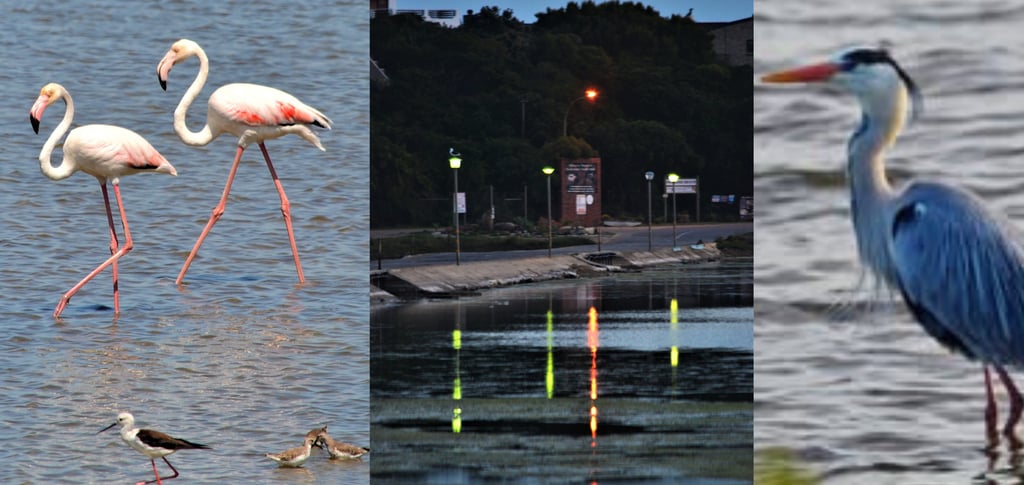Exploring Jeffreys Bay’s Nature Reserves and Walks: a guide to Kabeljous, Seekoei and the hidden wilds
A guide to the beautiful scenery of the nature reserves and walks in Jeffreys Bay.
9/11/20255 min read


Jeffreys Bay is known for its long, perfect waves and relaxed surf-town vibe — but step just a little way away from the sand and you’ll find quiet lagoons, tangled coastal thicket, wind-carved dunes and a surprising diversity of wildlife. The nature reserves around J-Bay—most notably the Kabeljous Lagoon / Kabeljous Nature Reserve and the Seekoei River Nature Reserve —offer some of the best, easiest-to-access nature walks in the Eastern Cape. Whether you’re a local looking for a morning escape or a visitor wanting a break from the surf, these reserves are perfect for hikes, birdwatching and a coastal wilderness that’s satisfying all year-round.
Why the reserves matter
The area around Jeffreys Bay sits in a unique ecological transition zone where several biomes meet. That means coastal dunes, fynbos pockets, riverine thicket and wetland habitats occur within a very short distance of each other—creating habitat variety and rich birdlife. The Kabeljous estuary in particular is considered one of the better-preserved estuaries in the province, and both Kabeljous and Seekoei are well-known among birders and conservationists for the number and variety of species they host.
Kabeljous Nature Reserve — river, lagoon and dune walks
The Kabeljous Nature Reserve is centred on the Kabeljous River and its lagoon. The reserve is pleasantly compact (the lagoon and immediate fynbos/dune system are the highlight) and offers a network of marked trails that vary from short strolls along the river to longer beach hikes. Walking options range between about 3 and 7 km depending on the route and starting point. There’s also a picnic area at the estuary.
What to expect on the walks: the lower river meanders into a broad lagoon that’s fringed by salt marsh and low dune vegetation; inland pockets of valley thicket and coastal bush support small antelope and a host of passerines. On any comfortable walk you might see duiker or grysbok tracks, hear sunbirds and chats, and — particularly in the lagoon’s shallows — spot herons, cormorants and seasonal waders. Pay special attention to viewpoints around the river bridge and along the lagoon edge: these are prime spots for African Fish Eagle, Goliath Heron and other signature species.
Practical notes for Kabeljous:
Entrance: the main gate is off the R102; there’s parking near the entrance and a short footpath leads into the reserve. Follow signage and stick to marked trails.
Trail difficulty: mostly easy to moderate — some dune climbs and uneven sections but nothing technical. Bring comfortable shoes, water, sun protection and binoculars.
Best time: early morning and late afternoon are ideal for bird activity and softer light for photos. Spring and autumn are often pleasantly cool and produce good plant and bird activity.
Seekoei River Nature Reserve — quiet lagoon and thicket walks
Between the suburbs of Aston Bay and Paradise Beach, lies the Seekoei River Nature Reserve. Though smaller in footprint than many large national reserves, Seekoei packs a lot of habitat into its 60–70 hectare footprint: dense bushes, fynbos pockets and an estuarine lagoon where the Seekoei and Swart rivers meet. The reserve is especially prized by birders — more than a hundred species have been recorded in the area, including resident and migrant shorebirds, raptors like osprey and resident thicket specialists.
The walking experience at Seekoei is intimate and historically low-key: narrow footpaths thread through dense coastal thicket that keeps wildlife feeling wild and undisturbed. There’s a compact circular trail (described in local guides) that can be done in a couple of hours and includes a bird-hide overlooking the lagoon — a wonderful spot for patient observation and photography. Seekoei’s quieter, wilder feel contrasts nicely with Kabeljous’ broader lagoon views, so many visitors combine both reserves into a half-day nature outing.
The images above are credited to Colin Brooks, a karaoke loving amateur photographer who graciously allowed us to use his images taken at the lagoon.
Trails, led walks and other routes worth knowing
Beyond the two headline reserves, Jeffreys Bay’s walking options include shorter “river walk” trails, dune-top promenades and a handful of community-maintained routes that are popular with trail-runners and locals. Online trail platforms list local routes such as the Kabeljous River trail, the Noorsekloof route and the Kromriviermond walk; these range from very short loops to longer mixed-terrain outings. Local tourism pages are good places to find user-updated route descriptions and GPS guidance.
A few user-friendly routes:
Kabeljous River Walk: riverside and lagoon views, great for birding and gentle enough for families.
Coastal dune and estuary loop: explore the dune edge and marshes; good for landscape photography and sunset walks.
Seekoei circular trail: a 2–3 hour route that threads thicket and lagoon-side hides; bring water and insect repellent.
Wildlife and birding highlights
The real star of Jeffreys Bay’s reserves is the birdlife: estuarine herons and waders (eg. Goliath Heron, Purple Heron and a variety of sandpipers and plovers), raptors like African Fish Eagle and Western Osprey, and thicket specialists such as Knysna Woodpecker and various sunbirds. Kabeljous and Seekoei are both part of regional birding circuits and can easily yield 50–100 species within a single good visit. For mammal lovers, sightings of small antelope (duiker, grysbok), mongooses, porcupine and occasionally bushpig are possible — often leaving only tracks and the thrill of knowing they’re nearby.
Conservation and respectful visiting
Both reserves are managed with conservation in mind; they’re sensitive estuarine systems that rely on protection from pollution, off-road driving and disturbance. A few simple principles help keep them healthy:
Keep to trails and observation hides; don’t pick plants or disturb nests.
Take your litter home (or use provided bins where available).
Dogs, open fires and motor vehicles are usually prohibited—check signage.
Local community groups, tourism outlets and Kouga Municipality occasionally run clean-ups, guided walks and awareness events—joining a guided walk is a great way to learn more about local ecology and support conservation efforts.
How to plan a visit (logistics & tips)
Getting there: Both reserves are only a short drive from central Jeffreys Bay. Kabeljous has a main entrance off the R102; Seekoei is accessible from roads serving Aston Bay / Paradise Beach. Parking is generally available at reserve gates.
What to bring: water, hat, sunscreen, insect repellent, good walking shoes, binoculars and a camera. In cooler months bring a warm layer; in summer start early to avoid mid-day heat.
Safety: these are low-risk walking areas, but basic precautions (tell someone your plan, carry a phone, respect signage) are sensible. Also be prepared for uneven ground, sand and occasional boggy sections near the lagoon margins.
Combine with surf/beach: it’s easy to do a morning nature walk and an afternoon on J-Bay’s beaches—pair a Kabeljous river loop with a picnic at one of the quieter sandbanks for an ideal day.
Best seasons and what you’ll see
Spring (Sep–Nov): flowering fynbos, active bird migrations, good temperatures for long walks.
Summer (Dec–Feb): lush estuary margins and high insect activity — early starts recommended.
Autumn (Mar–May): cooler days, excellent light for photography and steady bird activity.
Winter (Jun–Aug): crisp air, quieter trails and excellent raptor sightings.
Final thoughts: more than a surf town
Jeffreys Bay’s reserves remind you that coastal towns are often gateways to fascinating inland and estuarine habitats. For visitors who might otherwise see J-Bay only as “a great surf stop,” the Kabeljous and Seekoei reserves are gentle invitations to slow down, listen to estuary birds, and watch scrub and dune life at close quarters. Locals treasure these spaces as weekend escapes and nature classrooms; visitors will leave with the pleasant surprise that a few minutes’ drive away from the long rolling waves there’s another kind of rhythm—one of waders probing mud, reedbeds whispering in the wind, and the tiny flash of a sunbird by the track.


